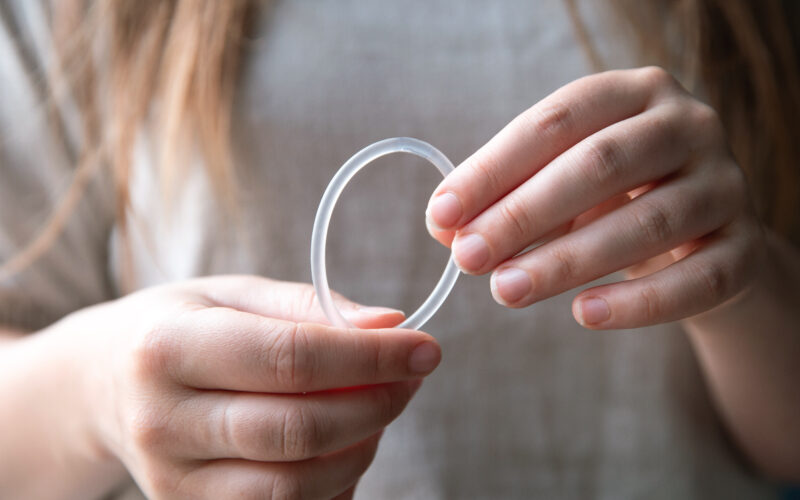“Why think about taking birth control every day?” This question greets visitors to the website of NuvaRing, the most well-known contraceptive ring brand in the U.S. Approved by the FDA in 2001, NuvaRing is a small, clear, flexible plastic ring inserted into the vagina. Like an IUD, it slowly releases microdoses of hormones so users don’t need to take a daily pill in order to prevent pregnancy. But unlike an IUD, which has to be inserted in a doctor’s office, NuvaRing users insert and remove their own birth control device. Since 2019, three versions of the birth control ring have been available: NuvaRing, its generic version EluRyng, and a version called Annovera that can be used continuously for up to a year.
Just “Insert, remove, repeat”?
The birth control ring is inserted into the vagina, left in place for three weeks, and removed for one week in order to cause withdrawal bleeding before replacing it to start the “cycle” again. (Reminder, here’s why you actually don’t have a cycle at all on hormonal birth control). NuvaRing and EluRyng require a new ring to be inserted each month. With Annovera, the same ring is reused for a full year.
Inserting the birth control ring just once a month sounds simple enough, but if the ring is taken out or falls out during the three-week wearing period, things get more complicated [1][2]. Why might the ring fall out? The ring is held in place by vaginal muscles, so it may fall out if those muscles are used in certain ways. The top 3 situations in which the ring may fall out are: during your period while pulling out a tampon, during sex, or while having a bowel movement.
What happens if the birth control ring falls out?
In order to remain effective at preventing pregnancy, the ring has to be replaced quickly (within three hours for NuvaRing, and within two hours for Annovera). If left out for longer during the first or second week of the cycle of use, users are instructed to replace it, but use “backup” contraception. If it falls out during the third week, the ring can be replaced or left out to start the one-week period.
How the vaginal ring prevents pregnancy
Like the pill, the birth control ring prevents pregnancy by releasing a combination of estrogen and progestin into the body. This suppresses ovulation, thickens the cervical mucus to inhibit the movement of sperm, and thins the uterine lining.
The vaginal ring is sometimes prescribed for reasons other than contraception
The birth control ring isn’t just used for contraception. It may also be prescribed for menstrual symptoms like heavy periods, migraines, period pain, and PMS, though it cannot get to the root of (and therefore cannot fix) why these symptoms are occurring. Compared to the pill, women who use the birth control ring experience less breakthrough bleeding during the three-week active phase, and more regular withdrawal bleeds during the week the ring is out [3]. It is sometimes worn continuously to suppress periods completely.
The vaginal ring may cause fewer side effects than other forms of birth control….
Because it delivers hormones directly into the bloodstream through the vaginal lining (bypassing the liver and gut altogether), the birth control ring only uses half the amount of estrogen contained in the pill to do the same job.
Avoiding the gastrointestinal (GI) system gives the ring some other relative advantages. It causes lower rates of nausea, and it also does not appear to affect glucose and lipid metabolism, making it a less risky choice than the birth control shot for women with insulin resistance or type 1 diabetes [4].
And at least one study found that the ring, unlike the combination pill and the patch, is just as effective in preventing pregnancy for overweight and obese women [5].
…But very few women use it
These benefits appear not to outweigh the downsides though, as the ring remains one of the least-used forms of birth control in the United States. Only about 1% of women reported current use between 2017 and 2019. One contributing factor may be the ring’s relatively high price tag. Like all FDA-approved birth control, the ring is free with insurance. But for the uninsured, it costs up to $220 per month, or a whopping $2,670 per year for Annovera.
Birth control ring-specific side effects
Women are more likely to discontinue using the birth control ring due to physical discomfort and other adverse effects, such as vaginal infections, which affect up to 14% of ring users [2]. At least one case of toxic shock syndrome has been linked to the birth control ring, though other research has shown that the bacteria produced in infections related to the ring were not those that cause TSS [6][7].
Another serious concern related to the ring is the risk of blood clots, which a Danish study found to be nearly twice as high as risk for women on the pill and six times higher compared to those not on birth control [8].
Another serious concern related to the ring is the risk of blood clots, which a Danish study found to be nearly twice as high as risk for women on the pill and six times higher compared to those not on birth control [8]. In 2008, a lawsuit was filed claiming that the type of progestin contained by NuvaRing, etonogestrel, led to a higher risk of blood clots. While the lawsuit resulted in stronger warnings being listed on the drug label, the same type of progestin continues to be used in both NuvaRing and EluRyng.
In 2011, 24-year-old Erika Langhart died of a double pulmonary embolism caused by the NuvaRing.
The bottom line on the birth control ring
Yes, some women may opt for NuvaRing because it’s effective for users with high BMI or because it causes less GI upset than the Pill. But from its higher risk of blood clots compared to other forms of hormonal birth control, to the possibility of its falling out during sex or other normal daily activities, there’s plenty not to love about the birth control ring.
Additional Reading:
Everything you need to know about Depo-Provera, the birth control shot
Your hormones during a natural cycle vs. your hormones on the Pill
Too much estrogen: The risks women on the birth control patch need to know about







